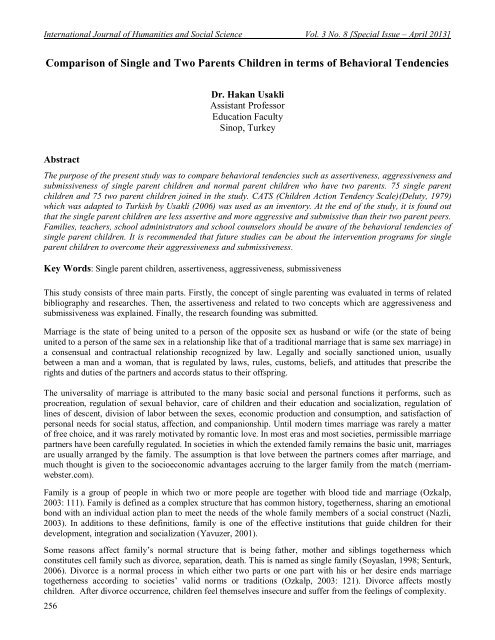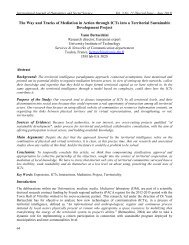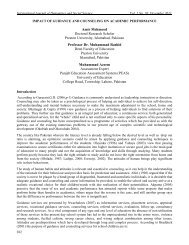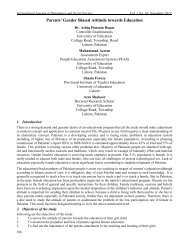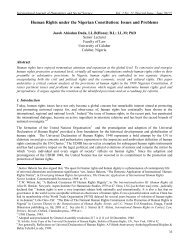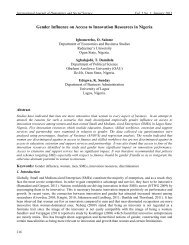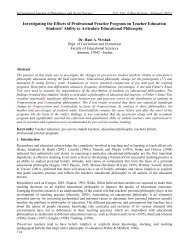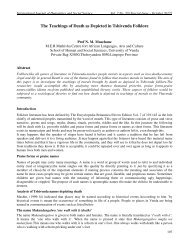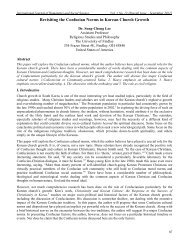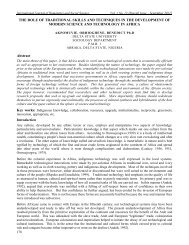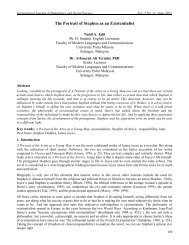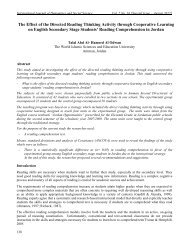Comparison of Single and Two Parents Children in terms of ...
Comparison of Single and Two Parents Children in terms of ...
Comparison of Single and Two Parents Children in terms of ...
You also want an ePaper? Increase the reach of your titles
YUMPU automatically turns print PDFs into web optimized ePapers that Google loves.
International Journal <strong>of</strong> Humanities <strong>and</strong> Social Science Vol. 3 No. 8 [Special Issue – April 2013]<br />
<strong>Comparison</strong> <strong>of</strong> <strong>S<strong>in</strong>gle</strong> <strong>and</strong> <strong>Two</strong> <strong>Parents</strong> <strong>Children</strong> <strong>in</strong> <strong>terms</strong> <strong>of</strong> Behavioral Tendencies<br />
Dr. Hakan Usakli<br />
Assistant Pr<strong>of</strong>essor<br />
Education Faculty<br />
S<strong>in</strong>op, Turkey<br />
Abstract<br />
The purpose <strong>of</strong> the present study was to compare behavioral tendencies such as assertiveness, aggressiveness <strong>and</strong><br />
submissiveness <strong>of</strong> s<strong>in</strong>gle parent children <strong>and</strong> normal parent children who have two parents. 75 s<strong>in</strong>gle parent<br />
children <strong>and</strong> 75 two parent children jo<strong>in</strong>ed <strong>in</strong> the study. CATS (<strong>Children</strong> Action Tendency Scale)(Deluty, 1979)<br />
which was adapted to Turkish by Usakli (2006) was used as an <strong>in</strong>ventory. At the end <strong>of</strong> the study, it is found out<br />
that the s<strong>in</strong>gle parent children are less assertive <strong>and</strong> more aggressive <strong>and</strong> submissive than their two parent peers.<br />
Families, teachers, school adm<strong>in</strong>istrators <strong>and</strong> school counselors should be aware <strong>of</strong> the behavioral tendencies <strong>of</strong><br />
s<strong>in</strong>gle parent children. It is recommended that future studies can be about the <strong>in</strong>tervention programs for s<strong>in</strong>gle<br />
parent children to overcome their aggressiveness <strong>and</strong> submissiveness.<br />
Key Words: <strong>S<strong>in</strong>gle</strong> parent children, assertiveness, aggressiveness, submissiveness<br />
This study consists <strong>of</strong> three ma<strong>in</strong> parts. Firstly, the concept <strong>of</strong> s<strong>in</strong>gle parent<strong>in</strong>g was evaluated <strong>in</strong> <strong>terms</strong> <strong>of</strong> related<br />
bibliography <strong>and</strong> researches. Then, the assertiveness <strong>and</strong> related to two concepts which are aggressiveness <strong>and</strong><br />
submissiveness was expla<strong>in</strong>ed. F<strong>in</strong>ally, the research found<strong>in</strong>g was submitted.<br />
Marriage is the state <strong>of</strong> be<strong>in</strong>g united to a person <strong>of</strong> the opposite sex as husb<strong>and</strong> or wife (or the state <strong>of</strong> be<strong>in</strong>g<br />
united to a person <strong>of</strong> the same sex <strong>in</strong> a relationship like that <strong>of</strong> a traditional marriage that is same sex marriage) <strong>in</strong><br />
a consensual <strong>and</strong> contractual relationship recognized by law. Legally <strong>and</strong> socially sanctioned union, usually<br />
between a man <strong>and</strong> a woman, that is regulated by laws, rules, customs, beliefs, <strong>and</strong> attitudes that prescribe the<br />
rights <strong>and</strong> duties <strong>of</strong> the partners <strong>and</strong> accords status to their <strong>of</strong>fspr<strong>in</strong>g.<br />
The universality <strong>of</strong> marriage is attributed to the many basic social <strong>and</strong> personal functions it performs, such as<br />
procreation, regulation <strong>of</strong> sexual behavior, care <strong>of</strong> children <strong>and</strong> their education <strong>and</strong> socialization, regulation <strong>of</strong><br />
l<strong>in</strong>es <strong>of</strong> descent, division <strong>of</strong> labor between the sexes, economic production <strong>and</strong> consumption, <strong>and</strong> satisfaction <strong>of</strong><br />
personal needs for social status, affection, <strong>and</strong> companionship. Until modern times marriage was rarely a matter<br />
<strong>of</strong> free choice, <strong>and</strong> it was rarely motivated by romantic love. In most eras <strong>and</strong> most societies, permissible marriage<br />
partners have been carefully regulated. In societies <strong>in</strong> which the extended family rema<strong>in</strong>s the basic unit, marriages<br />
are usually arranged by the family. The assumption is that love between the partners comes after marriage, <strong>and</strong><br />
much thought is given to the socioeconomic advantages accru<strong>in</strong>g to the larger family from the match (merriamwebster.com).<br />
Family is a group <strong>of</strong> people <strong>in</strong> which two or more people are together with blood tide <strong>and</strong> marriage (Ozkalp,<br />
2003: 111). Family is def<strong>in</strong>ed as a complex structure that has common history, togetherness, shar<strong>in</strong>g an emotional<br />
bond with an <strong>in</strong>dividual action plan to meet the needs <strong>of</strong> the whole family members <strong>of</strong> a social construct (Nazli,<br />
2003). In additions to these def<strong>in</strong>itions, family is one <strong>of</strong> the effective <strong>in</strong>stitutions that guide children for their<br />
development, <strong>in</strong>tegration <strong>and</strong> socialization (Yavuzer, 2001).<br />
Some reasons affect family‟s normal structure that is be<strong>in</strong>g father, mother <strong>and</strong> sibl<strong>in</strong>gs togetherness which<br />
constitutes cell family such as divorce, separation, death. This is named as s<strong>in</strong>gle family (Soyaslan, 1998; Senturk,<br />
2006). Divorce is a normal process <strong>in</strong> which either two parts or one part with his or her desire ends marriage<br />
togetherness accord<strong>in</strong>g to societies‟ valid norms or traditions (Ozkalp, 2003: 121). Divorce affects mostly<br />
children. After divorce occurrence, children feel themselves <strong>in</strong>secure <strong>and</strong> suffer from the feel<strong>in</strong>gs <strong>of</strong> complexity.<br />
256
The Special Issue on Contemporary Issues <strong>in</strong> Social Science<br />
© Centre for Promot<strong>in</strong>g Ideas, USA www.ijhssnet.com<br />
Most children th<strong>in</strong>k that one day, their father <strong>and</strong> mother will be together so they occupy themselves to f<strong>in</strong>d out<br />
solution that is useless. In order to solve conflict between parents, some <strong>of</strong> them prefer liv<strong>in</strong>g with one <strong>of</strong> them<br />
(Ozkalp, 2003).<br />
<strong>S<strong>in</strong>gle</strong>-parent families is a concept that def<strong>in</strong>es, families <strong>in</strong> which either the father or mother is absent because <strong>of</strong><br />
divorce, marital separation, out-<strong>of</strong> –wedlock pregnancy, or death (Greenberg, 2002: 329). 28 percent <strong>of</strong> all<br />
families with children still at home were ma<strong>in</strong>ta<strong>in</strong>ed by one parent. That amounts to over 12 million families <strong>and</strong><br />
over 20 million children. Eighty-four percent <strong>of</strong> the numbers <strong>of</strong> one parent families were headed by women <strong>in</strong><br />
1998. That amounted to over 9.8 million families. In addition, 2.1 million one-parent families were headed by<br />
men. This <strong>in</strong>crease <strong>in</strong> s<strong>in</strong>gle-parent families is a result <strong>of</strong> <strong>in</strong>crease marital separation, divorce, <strong>and</strong> out <strong>of</strong> wedlock<br />
pregnancies rather than widowhood. Further, <strong>in</strong> 1998, 63 percent <strong>of</strong> African American families with children at<br />
home, 37 percent <strong>of</strong> Hispanic families with children at home, <strong>and</strong> 27 percent <strong>of</strong> white families with children at<br />
home were ma<strong>in</strong>ta<strong>in</strong>ed by one parent (U.S. Census Bureau, 1999).<br />
Divorce occurs <strong>in</strong> the context <strong>of</strong> many factors that are co-occurr<strong>in</strong>g both before <strong>and</strong> after the divorce (Ellis, 2000).<br />
Wade <strong>and</strong> Travis (1990) called divorce as the break<strong>in</strong>g <strong>of</strong> attachment. Accord<strong>in</strong>g to them thirty years ago, divorce<br />
was rare <strong>and</strong> shameful. Today, divorce is as common as the flu <strong>and</strong> <strong>of</strong>ten strikes as unpredictably, to couples<br />
married only a year as well as to couples married for decades, affect<strong>in</strong>g one million children a year. A child born<br />
today has a 40 percent chance <strong>of</strong> liv<strong>in</strong>g through a second parental divorce by age 18. At least the stigma <strong>of</strong> be<strong>in</strong>g<br />
different no longer matters; we know a child who compla<strong>in</strong>s that she or he has only one set <strong>of</strong> parents.<br />
Despite its <strong>in</strong>creas<strong>in</strong>g prevalence, divorce cont<strong>in</strong>ues to be troubl<strong>in</strong>g, difficult, <strong>and</strong> pa<strong>in</strong>ful for children <strong>of</strong> all ages<br />
just as it is troubl<strong>in</strong>g for most divorc<strong>in</strong>g couples. One reason is that human be<strong>in</strong>gs do not break their attachments<br />
lightly, even bad attachments (Berman, 1988; Bowlby, 1988). Married couples who fought constantly are <strong>of</strong>ten<br />
surprised to discover, once separated, how emotionally attached they rema<strong>in</strong> to each other. <strong>Children</strong> <strong>of</strong>ten persist<br />
<strong>in</strong> their attachment to a cold or abusive parent long after the parent has ab<strong>and</strong>oned them.<br />
There are three factors seems to be very important <strong>in</strong> divorce these are child age, sex <strong>and</strong> family socioeconomic<br />
status. Accord<strong>in</strong>g to longitud<strong>in</strong>al studies, the effects <strong>of</strong> divorce depend on the child‟s gender, age at the time <strong>of</strong><br />
the parents‟ divorce <strong>and</strong> whether you are look<strong>in</strong>g at immediate or long-term reactions (Wallerste<strong>in</strong>, 1983;<br />
Wallerste<strong>in</strong> & Blakeslee, 1989).<br />
The general effects <strong>of</strong> divorce are;<br />
• Loss <strong>of</strong> concentration <strong>and</strong> attention<br />
• Decl<strong>in</strong><strong>in</strong>g grades <strong>and</strong> behavior problems at school<br />
• Withdrawal from friends<br />
• Emotional outbursts <strong>and</strong> health problems<br />
• Serious anger with one or both parents<br />
• Del<strong>in</strong>quency <strong>and</strong> substance use (samhsa.gov, 2011).<br />
We know little about the effects <strong>of</strong> divorce on children younger than two or three years <strong>of</strong> age. Young children do<br />
not always suffer if a divorce occurs. However, problems may occur if a close relationship or bond between a<br />
parent <strong>and</strong> child is broken. <strong>Parents</strong> should agree on parent<strong>in</strong>g <strong>and</strong> childcare arrangements so the child does not<br />
grow up experienc<strong>in</strong>g conflict between his or her parents. Infants may not underst<strong>and</strong> conflict, but may react to<br />
changes <strong>in</strong> parent‟s energy level <strong>and</strong> mood. Infants may loose their appetite or have an upset stomach <strong>and</strong> spit up<br />
more.<br />
Preschool-age children (ages 2 to 6) are the age group most immediately distressed by their parents‟ divorce, yet<br />
the group that does best <strong>in</strong> the long run. <strong>Children</strong> from three to five years <strong>of</strong> age frequently believe they have<br />
caused their parents‟ divorce. For example, they might th<strong>in</strong>k that if they had eaten their d<strong>in</strong>ner or done their<br />
chores when told to do so, Daddy wouldn‟t have gone away. Preschoolers may fear be<strong>in</strong>g left alone or ab<strong>and</strong>oned<br />
altogether. They may show baby-like behavior, such as want<strong>in</strong>g their security blanket or old toys, or they beg<strong>in</strong><br />
wett<strong>in</strong>g the bed. They may deny that anyth<strong>in</strong>g has changed, or they may become uncooperative, depressed, or<br />
angry. Although they want the security <strong>of</strong> be<strong>in</strong>g near an adult, they may act disobedient <strong>and</strong> aggressive.<br />
Preschoolers become extremely needy <strong>and</strong> anxious.<br />
257
International Journal <strong>of</strong> Humanities <strong>and</strong> Social Science Vol. 3 No. 8 [Special Issue – April 2013]<br />
Be<strong>in</strong>g egocentric <strong>in</strong> their th<strong>in</strong>k<strong>in</strong>g, they blame themselves for the divorce (“Daddy is leav<strong>in</strong>g because I left my<br />
toys on the stairs”). A year <strong>and</strong> a half later, about half <strong>of</strong> these children, especially the boys, are still deeply<br />
troubled. After five years, more than a third <strong>of</strong> them are still moderately to severely depressed. By adolescence,<br />
however, most have forgotten the distress <strong>and</strong> fears they felt at the time <strong>of</strong> the divorce <strong>and</strong> are less burdened by<br />
the divorce then older children.<br />
Yet many still speak sadly <strong>of</strong> the disruption <strong>and</strong> some still have fantasies <strong>of</strong> their parents‟ reconciliation. Almost<br />
all rema<strong>in</strong> emotionally attached to their fathers, whether the father visits them <strong>of</strong>ten more rarely, predictably or<br />
erratically.<br />
Elementary-school age children (Ages 7 to 12) are not as likely to blame themselves for the divorce, but most feel<br />
ab<strong>and</strong>oned <strong>and</strong> lonely nevertheless. They are better than preschoolers at express<strong>in</strong>g their feel<strong>in</strong>gs, but they have<br />
trouble manag<strong>in</strong>g conflict<strong>in</strong>g emotions toward the custodial parent, such as anger <strong>and</strong> sadness. They <strong>of</strong>ten fear<br />
that if they make that parent angry, he or she will leave them, too. Some psychologists believe the adjustment to<br />
parental divorce is more difficult for elementary school children than for younger or older children. School-age<br />
children are old enough to underst<strong>and</strong> that they are <strong>in</strong> pa<strong>in</strong> because <strong>of</strong> their parents‟ separation. They are too<br />
young, however, to underst<strong>and</strong> or to control their reactions to this pa<strong>in</strong>. They may experience grief,<br />
embarrassment, resentment, divided loyalty <strong>and</strong> <strong>in</strong>tense anger. Their ability to become actively <strong>in</strong>volved <strong>in</strong> play<br />
<strong>and</strong> activities with other children may help them cope with their family life situation. <strong>Children</strong> this age may hope<br />
parents will get back together. Elementary aged children may feel rejected by the parent who left. They may<br />
compla<strong>in</strong> <strong>of</strong> headaches or stomachaches.<br />
Adolescents (age 13 to 18) report frequent feel<strong>in</strong>gs <strong>of</strong> anger, sadness, shame, helplessness, <strong>and</strong> a sense <strong>of</strong> betrayal<br />
by the parents. They tend to cope by distanc<strong>in</strong>g themselves from their parents, rema<strong>in</strong><strong>in</strong>g alo<strong>of</strong> even a year <strong>of</strong><br />
more later. Teens also experience anger, fear, lonel<strong>in</strong>ess, depression <strong>and</strong> guilt.<br />
Some feel pushed <strong>in</strong>to adulthood if they must take responsibility for many new chores or care <strong>of</strong> sibl<strong>in</strong>gs. Teens<br />
may respond to parents‟ low energy level <strong>and</strong> high stress level by try<strong>in</strong>g to take control over the family. Others<br />
feel a loss <strong>of</strong> parental support <strong>in</strong> h<strong>and</strong>l<strong>in</strong>g emerg<strong>in</strong>g sexual feel<strong>in</strong>gs. Teens also may doubt for their own ability to<br />
get married or to stay married. Teens may underst<strong>and</strong> the causes lead<strong>in</strong>g to their parents‟ separation. Their ability<br />
to remember the conflict <strong>and</strong> stress <strong>of</strong> the divorce may <strong>in</strong>terfere with their ability to cope with the changes <strong>in</strong> their<br />
family. They may also feel pressure to “choose” one <strong>of</strong> their parents over the other, or to fault one parent over the<br />
other for the “cause” <strong>of</strong> the divorce. Girls may respond to parental divorce by becom<strong>in</strong>g sexually precocious<br />
(Hether<strong>in</strong>gton, Cox, & Cox, 1985). Boys may become sexually <strong>in</strong>secure <strong>and</strong> threatened, act<strong>in</strong>g out their feel<strong>in</strong>gs<br />
through drug use <strong>and</strong> aggression. Other boys become “super-macho,” exaggerat<strong>in</strong>g the male role. Because <strong>of</strong> their<br />
greater cognitive maturity, adolescents are better able than younger children to see the divorce as ma<strong>in</strong>ly the<br />
parents‟ problem. But for the same reason, they <strong>of</strong>ten become more distressful <strong>of</strong> the <strong>in</strong>stitution <strong>of</strong> marriage itself.<br />
College-age students (ages 18 to 22) <strong>in</strong>tellectually underst<strong>and</strong> <strong>and</strong> accept the reasons for their parents‟ divorce,<br />
but this underst<strong>and</strong><strong>in</strong>g does not reduce their emotional upheaval. Many report depression, stress, <strong>and</strong> feel<strong>in</strong>g <strong>of</strong><br />
<strong>in</strong>security. They are old enough to feel empathy for their parents, yet they <strong>of</strong>ten worry that no one appreciates<br />
their own grief <strong>and</strong> confusion (Cooney et al., 1986).<br />
The summary <strong>of</strong> developmental considerations as follows:<br />
3 to 5 years old children<br />
• Poor underst<strong>and</strong><strong>in</strong>g <strong>of</strong> the family situation<br />
• Feel<strong>in</strong>gs: frightened, <strong>in</strong>secure<br />
• May have nightmares, wh<strong>in</strong><strong>in</strong>g, cry<strong>in</strong>g, cl<strong>in</strong>g<strong>in</strong>g behavior<br />
• Temper tantrums<br />
• Changes <strong>in</strong> eat<strong>in</strong>g <strong>and</strong> sleep<strong>in</strong>g<br />
• Regression to more <strong>in</strong>fant like behavior<br />
6 to 8 year old children<br />
• Trouble separat<strong>in</strong>g their own needs from those <strong>of</strong> their parents<br />
• Feel sad, loss, frightened, uncerta<strong>in</strong><br />
• Generalized anxiety<br />
258
The Special Issue on Contemporary Issues <strong>in</strong> Social Science<br />
© Centre for Promot<strong>in</strong>g Ideas, USA www.ijhssnet.com<br />
• Disorganized <strong>and</strong> unsettled<br />
• School work problems<br />
• Feel<strong>in</strong>gs <strong>of</strong> ab<strong>and</strong>onment by <strong>and</strong> miss parent they don‟t see much<br />
• Anger at perceived rejection<br />
• Lash<strong>in</strong>g out at custodial parent, teachers, other children<br />
• Denial, self-blame, feels alienated<br />
• May attach themselves to other adults for security<br />
9 to 12 year old children<br />
• Sense <strong>of</strong> loss<br />
• Feel rejected, helpless, lonely, ashamed, embarrassed<br />
• Powerless to control parental behavior<br />
• Psychosomatic symptoms<br />
• Anger, withdrawn, overactive<br />
• Blame one parent for the divorce, direct anger<br />
• School work problems<br />
• Struggl<strong>in</strong>g with feel<strong>in</strong>gs <strong>of</strong> mixed loyalties, lonel<strong>in</strong>ess, depression<br />
• Power struggle with authority<br />
• May seek support from other adults outside <strong>of</strong> the home (Baris & Garrity, 1988; Johnston & Roseby, 1997;<br />
Wallerste<strong>in</strong> & Blakeslee, 2003; O‟Rourke & Worzbyt, 1996).<br />
Researchers are now f<strong>in</strong>d<strong>in</strong>g that boys rose by fathers <strong>and</strong> girls raised by mothers may do better than children<br />
raised by the parent <strong>of</strong> the opposite sex. School age boys liv<strong>in</strong>g with their fathers or <strong>in</strong> jo<strong>in</strong>t liv<strong>in</strong>g arrangements<br />
seem to be less aggressive. They also have fewer emotional problems than those boys who live with their mothers<br />
<strong>and</strong> have little or no contact with their fathers. Girls raised with mothers tend to be more responsible <strong>and</strong> mature<br />
than girls raised by their fathers.<br />
However, the children‟s adjustment follow<strong>in</strong>g a divorce has more to do with the quality <strong>of</strong> the parent-child<br />
relationship than with the gender <strong>and</strong> age <strong>of</strong> the child. Overall, girls adjust to divorce more easily than boys, <strong>and</strong><br />
one reason seems to be that boys suffer more by be<strong>in</strong>g separated from the father when the mother has custody<br />
(Guidubaldi & Perry, 1985). <strong>Children</strong> who live <strong>in</strong> jo<strong>in</strong>t custody or <strong>in</strong> custody <strong>of</strong> the same-sex parent show<br />
significantly more competence, maturity, cooperativeness, <strong>and</strong> self-esteem than children liv<strong>in</strong>g with the oppositesex<br />
parent.<br />
A child‟s ability to cope with divorce also depends on whether the parents settle <strong>in</strong>to amicable (or at least silent)<br />
relations or cont<strong>in</strong>ue to feel angry <strong>and</strong> conflicted. <strong>Children</strong> will eventually recover form the parents‟ divorce,<br />
unless the parents cont<strong>in</strong>ue to quarrel about visitation rights, take each other to court, or fight with each other at<br />
every visit (Wallerste<strong>in</strong> & Blakeslee, 1989). From the st<strong>and</strong>po<strong>in</strong>t <strong>of</strong> children‟s adjustment, an amicable divorce is<br />
better than a bitter marriage, but a prolonged <strong>and</strong> bitter divorce is worst <strong>of</strong> all.<br />
The impact <strong>of</strong> divorce on children <strong>of</strong> this age is more pr<strong>of</strong>ound. Wallerste<strong>in</strong> <strong>and</strong> Kelly (1980) found that children<br />
six to eight seem to have the hardest time <strong>of</strong> any age group. As they are old enough to realize what is happen<strong>in</strong>g<br />
but do not have adequate skills to deal with the disruption. They <strong>of</strong>ten feel a sense <strong>of</strong> responsibility, experience<br />
tremendous grief, <strong>and</strong> have a pervasive sadness <strong>and</strong> yearn<strong>in</strong>g for the departed parent. At the same time, they<br />
experience recurr<strong>in</strong>g fantasies <strong>of</strong> reconciliation <strong>and</strong> <strong>of</strong>ten th<strong>in</strong>k that they have the power to make it happen.<br />
F<strong>in</strong>d<strong>in</strong>gs from a variety <strong>of</strong> empirical research studies show that the quality <strong>of</strong> adult-child <strong>in</strong>teraction is related to<br />
children‟s <strong>in</strong>tellectual development <strong>and</strong> academic success. There is a large body <strong>of</strong> evidence on the prevalence <strong>of</strong><br />
mental <strong>and</strong> social retardation among children raised <strong>in</strong> orphanages or hospitals where the ratio <strong>of</strong> adults to<br />
children is low <strong>and</strong> there is little adult-child <strong>in</strong>teraction. The importance <strong>of</strong> <strong>in</strong>teraction with adults is underscored<br />
by the dramatic ga<strong>in</strong>s <strong>of</strong>ten made by <strong>in</strong>stitutionalized children when they received nurturance from substitute<br />
mothers, even if the substitutes were severely retarded themselves (Bocoock, 1980: 76). Academic achievement is<br />
very important for third <strong>and</strong> fourth grades because accord<strong>in</strong>g to Erikson‟s Theory <strong>of</strong> Psychosocial personality<br />
development they are <strong>in</strong> “Industry versus Inferiortiy” life transition (Thomas, 1979: 272).<br />
259
International Journal <strong>of</strong> Humanities <strong>and</strong> Social Science Vol. 3 No. 8 [Special Issue – April 2013]<br />
Competence is important <strong>in</strong> this period, the free use <strong>of</strong> skill <strong>and</strong> <strong>in</strong>telligence <strong>in</strong> complet<strong>in</strong>g tasks, unimpaired by<br />
<strong>in</strong>fantile <strong>in</strong>feriority. <strong>Children</strong> want to earn recognition by produc<strong>in</strong>g someth<strong>in</strong>g, to ga<strong>in</strong> the satisfaction <strong>of</strong><br />
complet<strong>in</strong>g work by perseverance. The child may have potential abilities which, if not evoked <strong>and</strong> nurtured dur<strong>in</strong>g<br />
latency, may develop later or never (Erikson, 1959: 87).<br />
When the divorce is bitter, children may be at risk psychologically if <strong>in</strong>volved <strong>in</strong> loyalty conflicts. Some children<br />
assume or are drawn <strong>in</strong>to parentified roles, tak<strong>in</strong>g on <strong>in</strong>appropriate adult responsibilities that are damag<strong>in</strong>g<br />
emotionally. They may develop school <strong>and</strong>/or peer problems characterized by poor performance, problematic<br />
behavior with peers or authority, <strong>and</strong>/or somatic symptoms (Wallerste<strong>in</strong> & Kelly, 1980).<br />
The older the children are at the time <strong>of</strong> separation, the easier it will be for the father to establish an effective<br />
parental role as he knows them as people, with personalities <strong>and</strong> <strong>in</strong>terests to which he can relate. However, as they<br />
get older <strong>and</strong> more <strong>in</strong>volved with peers <strong>and</strong> outside <strong>in</strong>volvements, they may draw back from the father both<br />
physically <strong>and</strong> emotionally, unless he is sensitive to their general desire to cut back on their time with parents, <strong>and</strong><br />
does not take it personally. The long-term consequences <strong>of</strong> parental divorce for adult atta<strong>in</strong>ment <strong>and</strong> quality <strong>of</strong> life<br />
may prove to be more serious than the short-term emotional <strong>and</strong> social problems <strong>in</strong> children (Amato & Keith,<br />
1991). One cannot predict long-term effects <strong>of</strong> divorce on children from how they react at the outset (Wallerste<strong>in</strong><br />
& Blakeslee, 1989). Research suggests that problematic parent-child relations associated with divorce persist<br />
throughout the life course (Amato <strong>and</strong> Booth,1996).<br />
<strong>Children</strong> from disrupted families are significantly more likely to express discontent with their lives as measured<br />
by an <strong>in</strong>dex <strong>of</strong> life satisfaction (Furstenberg & Teitler, 1994).<br />
Theories for the negative effect <strong>of</strong> divorce suggest that:<br />
Parental absence perspective<br />
– <strong>Two</strong> parents are better than one<br />
Economic disadvantage perspective<br />
– Increased stressors <strong>in</strong>clud<strong>in</strong>g parents feel<strong>in</strong>g socially isolated, changes <strong>in</strong> liv<strong>in</strong>g arrangements, economic<br />
hardship, visitation problems, cont<strong>in</strong>ued parental conflict<br />
Family conflict perspective<br />
– <strong>Children</strong> are affected negatively by parental conflict (Amato & Keith, 1991).<br />
Risk Factors<br />
• Custodial parent less effective <strong>in</strong> parent<strong>in</strong>g role<br />
• Less <strong>in</strong>volvement from noncustodial parent<br />
• Interparental hostility<br />
• Decl<strong>in</strong>e <strong>in</strong> economic resources<br />
• Series <strong>of</strong> disruptive life changes (Kelly, 2001).<br />
Numerous studies have found l<strong>in</strong>ks between the quality <strong>of</strong> the parents‟ relationship <strong>and</strong> positive outcomes for<br />
children <strong>and</strong> families (Amato, 2005). For example, children liv<strong>in</strong>g <strong>in</strong> s<strong>in</strong>gle-parent <strong>and</strong>/or low-<strong>in</strong>come households<br />
are more likely to exhibit problem behaviors <strong>and</strong> depressive symptoms <strong>and</strong> are less likely to display social<br />
competence than are children who grow up <strong>in</strong> more fortunate circumstances (Moore, et al., 2006). Most common<br />
problems seen <strong>in</strong> s<strong>in</strong>gle parent families‟ children are depression, stress, lonel<strong>in</strong>ess, aggression, compliance,<br />
smoke, alcohol, narcotics (Herw<strong>in</strong>g, et al., 2004; Jackson, 2000).<br />
Happy marriage makes for happy kids. On average, children <strong>in</strong> s<strong>in</strong>gle-parent families are more likely to have<br />
problems <strong>in</strong>clud<strong>in</strong>g depression <strong>and</strong> behavioral <strong>and</strong> social problems that the majority <strong>of</strong> children who are reared by<br />
both parents. A new study by the research group child trends stresses the importance <strong>of</strong> a child reared by two<br />
biological parents <strong>in</strong> a low conflict marriage for future health <strong>and</strong> happ<strong>in</strong>ess. (childtenrs.org). A substantial body<br />
<strong>of</strong> research has shown that, on average, children who are raised from birth <strong>in</strong> two-parent families have better<br />
cognitive <strong>and</strong> behavioral outcomes compared with children who have ever lived <strong>in</strong> s<strong>in</strong>gle-parent families, more<br />
than 80% <strong>of</strong> which are headed by s<strong>in</strong>gle mothers (Carlson & Corcoran, 2001; Fields & Casper, 2001;<br />
Hether<strong>in</strong>gton & Cl<strong>in</strong>gempeel, 1992; McLanahan & S<strong>and</strong>efur, 1994; Pryor & Rodgers, 2001).<br />
260
The Special Issue on Contemporary Issues <strong>in</strong> Social Science<br />
© Centre for Promot<strong>in</strong>g Ideas, USA www.ijhssnet.com<br />
Sometimes hav<strong>in</strong>g two parents is not enough for child who desired express wanted behaviors. Jaffee <strong>and</strong> et al.<br />
(2003) <strong>in</strong>dicate that, behavioral genetic analyses showed that children who resided with antisocial fathers received<br />
a double whammy <strong>of</strong> genetic <strong>and</strong> environmental risk for conduct problems. Marriage may not be the answer to the<br />
sources <strong>of</strong> emotional <strong>and</strong> economic support.<br />
In an overview <strong>of</strong> the role <strong>of</strong> fathers <strong>in</strong> children‟s development, Lamb (1997) summarized several reasons father<br />
absence is associated with poor outcomes for children, cit<strong>in</strong>g the emotional distress <strong>of</strong> s<strong>in</strong>gle mothers who may<br />
receive little social support, economic stressors, perceptions <strong>of</strong> ab<strong>and</strong>onment by children, <strong>and</strong> predivorce <strong>and</strong><br />
postdivorce marital conflict.<br />
National survey studies <strong>of</strong> family structure <strong>and</strong> children‟s outcomes consistently f<strong>in</strong>d that children raised <strong>in</strong> twoparent<br />
families do better than children raised <strong>in</strong> s<strong>in</strong>gle-parent families on measures <strong>of</strong> educational achievement<br />
<strong>and</strong> adjustment (Jaffee <strong>and</strong> et al., 2003: 109).<br />
These differences arise because children <strong>in</strong> s<strong>in</strong>gle-parent versus two-biological-parent families grow up <strong>in</strong> vastly<br />
different socioeconomic contexts <strong>and</strong> because s<strong>in</strong>gle mothers have lower educational atta<strong>in</strong>ment, less social<br />
support, <strong>and</strong> poorer psychological well-be<strong>in</strong>g (Carlson & Corcoran, 2001; Dunn, Deater-Deckard, Picker<strong>in</strong>g, &<br />
O‟Connor, 1998; McLanahan & S<strong>and</strong>efur, 1994; O‟Connor, Dunn, Jenk<strong>in</strong>s, Picker<strong>in</strong>g, & Rabash, 2001).<br />
With respect to socioeconomic context, researchers have found that as much as 50% <strong>of</strong> the association between<br />
family structure <strong>and</strong> adolescent <strong>and</strong> young adult outcomes, <strong>in</strong>clud<strong>in</strong>g school dropout, teen childbear<strong>in</strong>g, <strong>and</strong><br />
unemployment, can be accounted for by the fact that s<strong>in</strong>gle-parent families have lower <strong>in</strong>comes than two-parent<br />
families (McLanahan & S<strong>and</strong>efur, 1994). In a meta-analysis <strong>of</strong> 63 studies deal<strong>in</strong>g with nonresident fathers <strong>and</strong><br />
children‟s well-be<strong>in</strong>g, Amato <strong>and</strong> Gilbreth (1999) found that children had fewer behavioral problems <strong>and</strong> more<br />
academic success when fathers paid child support, when children felt emotionally close to their fathers, <strong>and</strong> when<br />
fathers engaged <strong>in</strong> authoritative parent<strong>in</strong>g practices.<br />
<strong>Children</strong> with s<strong>in</strong>gle parents showed <strong>in</strong>creased risks <strong>of</strong> psychiatric diseases, suicide or suicide attempt, <strong>in</strong>jury, <strong>and</strong><br />
addiction. After adjustment for confound<strong>in</strong>g factors, such as socioeconomic status <strong>and</strong> parents‟ addiction or<br />
mental disease, children <strong>in</strong> s<strong>in</strong>gle-parent households had <strong>in</strong>creased risks compared with those <strong>in</strong> two-parent<br />
households for psychiatric disease <strong>in</strong> childhood <strong>and</strong>, suicide attempt, alcohol-related disease <strong>and</strong> narcotics-related<br />
disease. Boys <strong>in</strong> s<strong>in</strong>gle-parent families were more likely to develop psychiatric disease <strong>and</strong> narcosis related<br />
disease than were girls, <strong>and</strong> they also had a risk <strong>of</strong> all-cause mortality. Grow<strong>in</strong>g up <strong>in</strong> a s<strong>in</strong>gle-parent family has<br />
disadvantages to the health or the child. Lack <strong>of</strong> household‟s resources plays a major part <strong>in</strong> <strong>in</strong>creased risks.<br />
However, even when a wide range <strong>of</strong> demographic <strong>and</strong> socioeconomic circumstances are <strong>in</strong>cluded <strong>in</strong> multivariate<br />
models, children <strong>of</strong> s<strong>in</strong>gle parents still have <strong>in</strong>creased risks <strong>of</strong> mortality severe morbidity, <strong>and</strong> <strong>in</strong>jury (Weit<strong>of</strong>t, at<br />
al., 2003).<br />
The is a strong relationship between hous<strong>in</strong>g status <strong>and</strong> depression, anxiety <strong>and</strong> problem behaviors among<br />
children <strong>of</strong> low-<strong>in</strong>come, s<strong>in</strong>gle-parent, female-headed families (Buckner <strong>and</strong> Bassuk, 1999).<br />
<strong>Children</strong> liv<strong>in</strong>g with only one parent fare considerably worse <strong>in</strong> school. But the study, entitled "The Most<br />
Significant M<strong>in</strong>ority: One-Parent <strong>Children</strong> <strong>in</strong> the Schools," was immediately <strong>and</strong> strongly attacked as<br />
"mislead<strong>in</strong>g" <strong>and</strong> damag<strong>in</strong>g by several education groups. About 40 percent <strong>of</strong> elementary school children who<br />
come from s<strong>in</strong>gle-parent families are classified as "low achievers," accord<strong>in</strong>g to the study <strong>of</strong> 18,000 pupils <strong>in</strong> 14<br />
states <strong>in</strong> the country. considerable evidence <strong>of</strong> behavioral problems among s<strong>in</strong>gle-parent children. For example,<br />
these children were twice as likely to be suspended or expelled from school <strong>and</strong> averaged eight more days <strong>of</strong><br />
absence each school year (Savage, 1980).<br />
Results <strong>in</strong>dicated that children from two-parent families consistently scored lower on measures <strong>of</strong> externaliz<strong>in</strong>g<br />
behavior <strong>and</strong> hyperactivity when compared to children from parent-absent households, but not when compared to<br />
those from s<strong>in</strong>gle-parent households. Moderation analyses revealed significant <strong>in</strong>teractions between family<br />
structure <strong>and</strong> children's gender. Girls <strong>in</strong> s<strong>in</strong>gle-mother households scored higher <strong>in</strong> externaliz<strong>in</strong>g behavior <strong>and</strong><br />
hyperactivity than those <strong>in</strong> two-parent households. Behavior problems for boys <strong>in</strong> s<strong>in</strong>gle-mother households did<br />
not differ from those <strong>in</strong> two-parent households. These f<strong>in</strong>d<strong>in</strong>gs encourage further research on parent<strong>in</strong>g practices<br />
<strong>and</strong> child's gender with<strong>in</strong> various family structures (Mokrue, et al., 2012).<br />
261
International Journal <strong>of</strong> Humanities <strong>and</strong> Social Science Vol. 3 No. 8 [Special Issue – April 2013]<br />
Indicated greater cross-generational cont<strong>in</strong>uity <strong>in</strong> s<strong>in</strong>gle-parent families; <strong>in</strong> families low <strong>in</strong> proactive teach<strong>in</strong>g,<br />
monitor<strong>in</strong>g, <strong>and</strong> academic <strong>in</strong>volvement; <strong>and</strong> <strong>in</strong> families with lower-IQ children who performed poorly <strong>in</strong> school<br />
<strong>and</strong> were disliked by peers (Pettit et al., 2009).<br />
Only a low level <strong>of</strong> education <strong>of</strong> the mother <strong>and</strong> the fact the child is liv<strong>in</strong>g <strong>in</strong> a s<strong>in</strong>gle parent family is consistently<br />
associated with negative outcomes. This is not true, however, for a whole range <strong>of</strong> other characteristics, like the<br />
work schedule <strong>of</strong> the parents, the sex <strong>of</strong> the child, the child's rank <strong>in</strong> the l<strong>in</strong>e <strong>of</strong> sibl<strong>in</strong>gs or the number <strong>of</strong> children<br />
<strong>in</strong> the household. Consequently, policy makers should be wary <strong>of</strong> quick conclusions when presented with results<br />
from s<strong>in</strong>gle <strong>in</strong>dicator research.<br />
Educational lagg<strong>in</strong>g, for example, may seem a very objective measure <strong>of</strong> problems, yet it does not necessarily<br />
co<strong>in</strong>cide with problematic behavior nor a parental perception <strong>of</strong> special needs (Ghysels <strong>and</strong> Van Vlasselaer,<br />
2008). There are commonalities <strong>and</strong> differences among these three approaches <strong>and</strong> their predictions. In general,<br />
they suggest that youth <strong>in</strong> first-married family units should be advantaged <strong>in</strong> <strong>terms</strong> <strong>of</strong> adjustment <strong>and</strong> well-be<strong>in</strong>g<br />
<strong>and</strong> that adolescents who have experienced parental divorce <strong>and</strong> those <strong>in</strong> s<strong>in</strong>gle-parent families are disadvantaged<br />
(Demo <strong>and</strong> Acock, 1996: 461).<br />
Many theories <strong>of</strong> adolescent development emphasize extra familial <strong>in</strong>fluences, especially peer group affiliation<br />
<strong>and</strong> friendship relations, <strong>and</strong> suggest a reduced role for families as adolescents seek <strong>in</strong>dependence <strong>and</strong> distance<br />
themselves from parents (Bell, 1981; Douvan & Adelson, 1966; Youniss & Smollar, 1985). Adolescence may<br />
very well be a life stage punctuated by parent-adolescent disagreement (Coll<strong>in</strong>s, 1990; Montemayor, 1986) <strong>and</strong> by<br />
<strong>in</strong>creas<strong>in</strong>g peer <strong>and</strong> extra familial <strong>in</strong>volvement, but our f<strong>in</strong>d<strong>in</strong>gs underscore the pivotal role that relationships with<br />
parents play <strong>in</strong> shap<strong>in</strong>g the socio-emotional, academic, <strong>and</strong> global well-be<strong>in</strong>g <strong>of</strong> adolescents. As important as<br />
other contexts are for adolescent development, these results reaffirm the pervasive <strong>in</strong>fluence <strong>of</strong> family relations.<br />
With the acceleration <strong>of</strong> the divorce rate from the mid-1960s to the early 1980s, the numbers <strong>of</strong> nontraditional<br />
families (such as s<strong>in</strong>gle-parent families <strong>and</strong> reconstituted families) have <strong>in</strong>creased relative to <strong>in</strong>tact, first-time<br />
nuclear families. This article reviews empirical evidence address<strong>in</strong>g the relationship between divorces, family<br />
composition <strong>and</strong> children's well-be<strong>in</strong>g. Although not entirely consistent, the pattern <strong>of</strong> empirical f<strong>in</strong>d<strong>in</strong>gs suggests<br />
that children's emotional adjustment, gender-role orientation, <strong>and</strong> antisocial behavior are affected by family<br />
structure, whereas other dimensions <strong>of</strong> well-be<strong>in</strong>g are unaffected. But the review <strong>in</strong>dicates that these f<strong>in</strong>d<strong>in</strong>gs<br />
should be <strong>in</strong>terpreted with caution because <strong>of</strong> the methodological deficiencies <strong>of</strong> many <strong>of</strong> the studies on which<br />
these f<strong>in</strong>d<strong>in</strong>gs are based. Several variables, <strong>in</strong>clud<strong>in</strong>g the level <strong>of</strong> family conflict, may be central variables<br />
mediat<strong>in</strong>g the effect <strong>of</strong> family structure on children (Demo & Acock, 1988).<br />
<strong>Children</strong> <strong>in</strong> mother-only families are more likely to be poor <strong>in</strong> adulthood than children who live with both parents.<br />
They are also more likely to become s<strong>in</strong>gle parents themselves. Economic deprivation, parental practices, <strong>and</strong><br />
neighborhood conditions all contribute to lower socioeconomic mobility. (McLanahan & Booth, 1989).<br />
After close look <strong>in</strong>to the concept <strong>of</strong> s<strong>in</strong>gle parent now assertiveness <strong>and</strong> two related concepts aggressiveness <strong>and</strong><br />
submissiveness will be exam<strong>in</strong>ed.<br />
Assertiveness is considered to be the ideal style <strong>of</strong> communicat<strong>in</strong>g. It is about giv<strong>in</strong>g equal importance to <strong>and</strong><br />
be<strong>in</strong>g able to f<strong>in</strong>ely balance between the goals <strong>and</strong> the relationships. It <strong>in</strong>volves be<strong>in</strong>g able to say no effectively,<br />
be<strong>in</strong>g able to express thoughts, feel<strong>in</strong>g, op<strong>in</strong>ions freely. Assertiveness is also about ask<strong>in</strong>g for help or apologiz<strong>in</strong>g<br />
without feel<strong>in</strong>g belittled. In short it is about respect toward self as well as others. Aggressiveness is giv<strong>in</strong>g more<br />
importance to your goals than to your relationships. At times lack <strong>of</strong> respect for others, their thoughts, feel<strong>in</strong>gs,<br />
op<strong>in</strong>ions, values etc. It can also be seen nonverbal behaviors. Aggressiveness is expressed either directly or<br />
passively. Passive aggression <strong>in</strong>cludes gossip<strong>in</strong>g, taunt<strong>in</strong>g, crack<strong>in</strong>g a mean joke etc. Submissiveness is giv<strong>in</strong>g<br />
more importance to one's relationship with others at the cost <strong>of</strong> one's goals. Difficulty say<strong>in</strong>g no, lett<strong>in</strong>g the other<br />
make a decision not be<strong>in</strong>g able to make a request are typical observations with submissive behavior<br />
(wiki.answers.com, 2013).<br />
<strong>Children</strong> behave aggressively, assertively, or submissively for a wide variety <strong>of</strong> reasons; generally, a comb<strong>in</strong>ation<br />
<strong>of</strong> factors underlies how a particular child will behave <strong>in</strong> any given situation.<br />
262
The Special Issue on Contemporary Issues <strong>in</strong> Social Science<br />
© Centre for Promot<strong>in</strong>g Ideas, USA www.ijhssnet.com<br />
These factors <strong>in</strong>clude how the child perceive those situations, what response alternatives she or he can th<strong>in</strong>k <strong>of</strong>,<br />
<strong>and</strong> what she or he will be the consequences <strong>of</strong> each response alternatively.<br />
The assertive child expresses herself or himself openly <strong>and</strong> directly while respect<strong>in</strong>g the rights <strong>and</strong> feel<strong>in</strong>gs <strong>of</strong><br />
others. For example, <strong>in</strong> response to be<strong>in</strong>g teased about her new hair-cut any child says calmly, assertively, “Please<br />
stop teas<strong>in</strong>g me. You wouldn‟t like it if I made fun <strong>of</strong> you. I really like the way my hair looks. “If assertiveness<br />
entails both self-expression <strong>and</strong> the non-violation <strong>of</strong> others‟ rights, then unassertiveness can take one <strong>of</strong> two<br />
forms: aggressiveness or submissiveness. Aggressive children express their thoughts <strong>and</strong> feel<strong>in</strong>gs openly, but the<br />
do so coercively <strong>and</strong> at other people‟s expense. Submissive children take <strong>in</strong>to account the feel<strong>in</strong>gs, power <strong>and</strong>/or<br />
authority <strong>of</strong> others, but deny (or do not st<strong>and</strong> up for) their own rights <strong>and</strong> feel<strong>in</strong>gs. For some aggressive children<br />
<strong>and</strong> for some submissive children, the thought <strong>of</strong> act<strong>in</strong>g assertively simply never occurs to them. These children<br />
see their options as limited to fight or flight.<br />
Other aggressive <strong>and</strong> submissive children, however can conceive <strong>of</strong> assertive alternatives, but choose not to<br />
exhibit such behavior because they believe that aggressive or submissive acts will yield grater benefits <strong>and</strong>/or<br />
costs than assertive behaviors (Deluty, 2004: 32; Deluty & Usakli, 2009: 20).<br />
From 1970s to today ma<strong>in</strong>ly <strong>in</strong> United States <strong>of</strong> America, be<strong>in</strong>g assertive is one <strong>of</strong> chief issues that draw people‟s<br />
attentions. Alberti & Emmons, (1998) state that any children can behave <strong>in</strong> three different styles. These are<br />
assertive, aggressive <strong>and</strong> submissive. An assertive behavior is see<strong>in</strong>g equality <strong>in</strong> relations, without unnecessary<br />
anxieties, protect<strong>in</strong>g our benefits, express<strong>in</strong>g our feel<strong>in</strong>gs, ideas honestly <strong>and</strong> be<strong>in</strong>g aware <strong>of</strong> other people‟ rights.<br />
Behav<strong>in</strong>g assertive, children‟s assertiveness, fundamentals <strong>of</strong> aggression <strong>and</strong> submission <strong>and</strong> assertiveness<br />
tra<strong>in</strong><strong>in</strong>g programs are also issues <strong>of</strong> researches conducted <strong>in</strong> Turkey (Ari, 1989; Culha & Dereli, 1987; Voltan,<br />
1980).<br />
Adler (1994) clarifies aggressive characters such as, arrogance, greed, jealousy, meanness <strong>and</strong> hatred; <strong>in</strong> contrast<br />
to these, submissive people express alienation, the fear, timidity <strong>and</strong> lowered adaptation. Any person who has<br />
failure <strong>in</strong> his or her desires or wants cannot reach his or her goals so this cause aggression, submission,<br />
unhapp<strong>in</strong>ess <strong>and</strong> desperation (Cuceloglu, 1993: 309).<br />
Deluty (1981) highlights five major areas <strong>in</strong> the field <strong>of</strong> children‟s assertiveness that have received <strong>in</strong>sufficient<br />
attention by researchers <strong>and</strong> cl<strong>in</strong>ical practitioners. These areas <strong>in</strong>clude the nature <strong>and</strong> components <strong>of</strong> verbal <strong>and</strong><br />
nonverbal assertiveness; cognitive <strong>and</strong> affective mediators <strong>of</strong> assertive expression, the <strong>in</strong>fluence <strong>of</strong> parental<br />
values, attitudes, <strong>and</strong> practice, the addictiveness <strong>and</strong> successfulness <strong>of</strong> assertive versus unassertive behavior, <strong>and</strong><br />
the assessment <strong>and</strong> treatment <strong>of</strong> specific assertiveness deficits <strong>and</strong> <strong>in</strong>hibitions.<br />
Between years <strong>of</strong> 1960s <strong>and</strong> 1990s there are many researches about assertiveness (Brown & Elliot, 1965;<br />
O‟Connor, 1969; O‟Connor, 1972; P<strong>in</strong>kston et al., 1973; Toph<strong>of</strong>f, 1973; Keller & Carlson, 1974; Cooke &<br />
Apolloni, 1976; Borste<strong>in</strong> et al., 1980). These researches exam<strong>in</strong>ed the nature <strong>of</strong> aggressive <strong>and</strong> submissive<br />
behaviors, measur<strong>in</strong>g <strong>and</strong> evaluat<strong>in</strong>g assertiveness <strong>and</strong> <strong>in</strong>terventional assertiveness tra<strong>in</strong><strong>in</strong>gs <strong>and</strong> programs.<br />
Assertive behavior has been variously def<strong>in</strong>ed as the “proper expression <strong>of</strong> any emotion other than anxiety toward<br />
another person” (Wolpe, 1973: p.81); as “the act <strong>of</strong> declar<strong>in</strong>g oneself, <strong>of</strong> stat<strong>in</strong>g this is who I am, what I th<strong>in</strong>k <strong>and</strong><br />
feel” (Fensterheim, 1972, p. 161); as <strong>in</strong>terpersonal behavior that <strong>in</strong>volves the direct expression <strong>of</strong> thoughts <strong>and</strong><br />
feel<strong>in</strong>gs <strong>in</strong> a socially acceptable manner (Rimm & Masters, 1974); <strong>and</strong> as effective social problem-solv<strong>in</strong>g<br />
behavior (Goldfried & Goldfried, 1975).<br />
The person who impels his desire for self-assertion to excessive proportions by express<strong>in</strong>g his op<strong>in</strong>ions <strong>in</strong> a<br />
hostile, threaten<strong>in</strong>g, or assaultive manner is aggressive. The aggressive person shows little or no consideration for<br />
the rights <strong>of</strong> others. The person who behaves aggressively does not recognize the potential consequences <strong>of</strong> his<br />
action <strong>and</strong> does not assume responsibility for them. It is for these reasons that aggressive behavior <strong>of</strong>ten results <strong>in</strong><br />
unfavorable consequences for the aggressor as well as for the object <strong>of</strong> aggression. By contrast, assertive behavior<br />
is expressed with consideration <strong>of</strong> mutual rights <strong>and</strong> the possible outcome that may follow. Accord<strong>in</strong>gly, the<br />
assertive person has a better chance <strong>of</strong> obta<strong>in</strong><strong>in</strong>g satisfactory remedy <strong>in</strong> a situation where expectancy has been<br />
violated (Fornell & Westbrook, 1979). The verb „assert‟ means: to declare someth<strong>in</strong>g as true; to ma<strong>in</strong>ta<strong>in</strong> or<br />
defend one‟s claim or right; or to put oneself forward boldly <strong>and</strong> <strong>in</strong>sistently. Strictly speak<strong>in</strong>g, the assertive skills<br />
are not part <strong>of</strong> the counsel<strong>in</strong>g process as such, yet they are <strong>of</strong> great importance.<br />
263
International Journal <strong>of</strong> Humanities <strong>and</strong> Social Science Vol. 3 No. 8 [Special Issue – April 2013]<br />
Assertive skills help to def<strong>in</strong>e the boundary between the need to express one‟s personal needs authentically, <strong>and</strong><br />
the desire to meet another‟s needs empathically a tension that must be balanced for counselors to live fully <strong>and</strong><br />
effectively. Aggression refers to a loose cluster <strong>of</strong> actions <strong>and</strong> motive around the theme <strong>of</strong> <strong>in</strong>tent by one <strong>in</strong>dividual<br />
to hurt or control another. The antecedents <strong>of</strong> aggressive behavior <strong>in</strong> children <strong>and</strong> the relationship between<br />
aggression <strong>and</strong> learn<strong>in</strong>g are not very clear. It seems that extremes <strong>of</strong> parental behavior are most likely to produce<br />
this behavioral motive (Boocock, 1980: 76).<br />
Both permissiveness <strong>and</strong> punishment have been shown to contribute to the development <strong>of</strong> aggressiveness <strong>in</strong><br />
young children. S<strong>in</strong>ce these two qualities <strong>of</strong> parental behavior can vary somewhat <strong>in</strong>dependently, there is<br />
possibility <strong>of</strong> variation <strong>in</strong> the amount <strong>of</strong> aggression produced <strong>in</strong> children simply by virtue <strong>of</strong> comb<strong>in</strong><strong>in</strong>g different<br />
degrees <strong>of</strong> these antecedents (Sears, 1965: 134).<br />
Different temperaments differentially expose children to certa<strong>in</strong> life circumstances. For example, a violent parent<br />
might be more likely to abuse an aggressive child than a placat<strong>in</strong>g, passive child. In addition, different<br />
temperaments cause children to react differently to similar life circumstances. A shy child may become<br />
<strong>in</strong>creas<strong>in</strong>gly withdrawn <strong>and</strong> dependent on a neglectful mother, whereas a sociable child <strong>of</strong> the same mother may<br />
develop <strong>in</strong>dependence <strong>and</strong> make other, more positive connections. The <strong>in</strong>teraction <strong>of</strong> temperament <strong>and</strong> early life<br />
events produces different cop<strong>in</strong>g styles <strong>in</strong> each child (Dobson, 2010: 320).<br />
Maladaptive Cop<strong>in</strong>g Modes: <strong>in</strong>dividual acts <strong>in</strong> a passive, subservient, submissive, approval-seek<strong>in</strong>g, or selfdeprecat<strong>in</strong>g<br />
way around others out <strong>of</strong> fear <strong>of</strong> conflict or rejection; tolerates abuse <strong>and</strong>/or bad treatment; does not<br />
express healthy needs or desires to others; selects people or engages <strong>in</strong> other behavior that directly ma<strong>in</strong>ta<strong>in</strong>s the<br />
self-defeat<strong>in</strong>g schema-driven pattern (Dobson, 2010: 330).<br />
Assertiveness is the balance between aggressive <strong>and</strong> submissive behavior <strong>and</strong> it is commonly misunderstood as<br />
aggression. Gett<strong>in</strong>g your way or w<strong>in</strong>n<strong>in</strong>g at the expense <strong>of</strong> someone else may momentarily feel good but that is<br />
aggression not assertiveness. The short feel good factor can subsequently be diluted by the after effects <strong>of</strong> such<br />
behavior. For <strong>in</strong>stance, if you have used your position to put pressure on someone, they will probably do what you<br />
ask. However, you may have lost their loyalty <strong>and</strong> respect <strong>in</strong> the long term. We also <strong>of</strong>ten mistake aggressive<br />
behavior as loud <strong>and</strong> angry but <strong>in</strong> fact aggression can come <strong>in</strong> many forms <strong>and</strong> identify<strong>in</strong>g it is part <strong>of</strong> the key to<br />
succeed<strong>in</strong>g <strong>in</strong> develop<strong>in</strong>g ref<strong>in</strong>ed assertiveness skills. Aggressive behavior is best def<strong>in</strong>ed as gett<strong>in</strong>g your way, but<br />
at the expense <strong>of</strong> someone else. You may have done this politely <strong>and</strong> with a smile but you will still have been<br />
aggressive. It follows, therefore, that submissive behavior is the opposite. This is where you let someone else have<br />
their way at your expense. Be<strong>in</strong>g submissive may appear to lead to an easy life <strong>in</strong> the first <strong>in</strong>stance but the<br />
cumulative effect can create problems <strong>in</strong> the long term. For example, not be<strong>in</strong>g able to say no to tasks not only<br />
overloads you but makes you feel bad about yourself. Be<strong>in</strong>g constantly submissive makes people respect you less<br />
<strong>and</strong>, what is wore, you respect yourself less. Submissive <strong>and</strong> aggressive behaviors both arise from a feel<strong>in</strong>g <strong>of</strong><br />
lower self-worth or fear <strong>and</strong> act to re<strong>in</strong>force this feel<strong>in</strong>g. They are self-perpetuat<strong>in</strong>g. Any ga<strong>in</strong> from us<strong>in</strong>g them is<br />
short term. Submissiveness may reduce anxiety <strong>in</strong> the short term but will result <strong>in</strong> disappo<strong>in</strong>tment <strong>in</strong> the self <strong>and</strong><br />
<strong>in</strong>crease the <strong>in</strong>ability to act assertively. Assertive behavior describes the middle approach where no one is left<br />
feel<strong>in</strong>g badly treated <strong>and</strong> all parties come out <strong>of</strong> the encounter feel<strong>in</strong>g full <strong>of</strong> worth. Assertive behavior makes you<br />
feel better at the time <strong>and</strong> makes it more likely that you will be assertive <strong>in</strong> the future as it is confidence build<strong>in</strong>g<br />
(Lee-Davies & Bailey, 2007, 128).<br />
Divorce is one <strong>of</strong> chief issues <strong>of</strong> the word. It is the fact that divorce is not only effect parties but also deeply effect<br />
children. Every child from s<strong>in</strong>gle parents is express<strong>in</strong>g unwanted behaviors. Express<strong>in</strong>g desired behaviors <strong>in</strong><br />
social sett<strong>in</strong>gs is very crucial for children. That is why it shows children socialization process. It is very important<br />
to f<strong>in</strong>d out the differences behavioral tendencies between s<strong>in</strong>gle <strong>and</strong> two parent children.<br />
The aim <strong>of</strong> this study is to f<strong>in</strong>d out differences between behavioral tendencies these are assertiveness,<br />
aggressiveness <strong>and</strong> submissiveness <strong>of</strong> s<strong>in</strong>gle parent children <strong>and</strong> normal two parent children. For this aim three<br />
hypotheses will be tested <strong>in</strong> the study. These are; there is no significant differences between s<strong>in</strong>gle <strong>and</strong> two parent<br />
children‟ assertiveness, there is no significant differences between s<strong>in</strong>gle <strong>and</strong> two parent children‟ aggressiveness<br />
<strong>and</strong> there is no significant differences between s<strong>in</strong>gle <strong>and</strong> two parent children‟ submissiveness. The study is<br />
limited with only third <strong>and</strong> forth grades elementary school students <strong>in</strong> S<strong>in</strong>op Turkey.<br />
264
The Special Issue on Contemporary Issues <strong>in</strong> Social Science<br />
© Centre for Promot<strong>in</strong>g Ideas, USA www.ijhssnet.com<br />
Method<br />
Subjects<br />
75 s<strong>in</strong>gle parents <strong>and</strong> 75 two parents children attend<strong>in</strong>g 3. <strong>and</strong> 4. elementary grades <strong>in</strong> S<strong>in</strong>op <strong>in</strong> Turkey jo<strong>in</strong>ed <strong>in</strong><br />
the study. Although all elementary 3. <strong>and</strong> 4. grades s<strong>in</strong>gle parent students jo<strong>in</strong>ed <strong>in</strong> the study but 75 students from<br />
two parents children were selected at r<strong>and</strong>om. For example, if an elementary school <strong>of</strong> 3 A grade has one s<strong>in</strong>gle<br />
parent male student from that class, a male student whose school number ends with n<strong>in</strong>e was selected. If an<br />
elementary school <strong>of</strong> 4 B grade has two s<strong>in</strong>gle parent female students from that class, two female students whose<br />
numbers end with one <strong>and</strong> second were selected. If end <strong>of</strong> school numbers are one <strong>and</strong> n<strong>in</strong>e students are not<br />
female the first follow<strong>in</strong>g number female students was selected. Before the study permissions from school<br />
adm<strong>in</strong>istrations <strong>and</strong> parents were gathered.<br />
Instrument <strong>and</strong> Procedure<br />
The <strong>Children</strong> Action Tendency Scale (CATS), measures assertive, aggressive, <strong>and</strong> submissive behavior <strong>in</strong><br />
children. It ascerta<strong>in</strong>s how a child would respond <strong>in</strong> 13 situations <strong>in</strong>volv<strong>in</strong>g frustration, provocation, <strong>and</strong> conflict.<br />
Each <strong>of</strong> the 13 situations is followed by three response alternatives (one aggressive, one assertive, <strong>and</strong> one<br />
submissive) presented <strong>in</strong> a paired-comparison format<br />
CATS was group adm<strong>in</strong>istered to the children <strong>in</strong> their classrooms. The experimenter emphasized to the children<br />
the importance <strong>of</strong> answer<strong>in</strong>g honesty, po<strong>in</strong>t<strong>in</strong>g out that the purpose <strong>of</strong> the questioner was to f<strong>in</strong>d out what children<br />
would do <strong>in</strong> certa<strong>in</strong> situations <strong>and</strong> not what they should do.<br />
The number <strong>of</strong> aggressive, assertive, <strong>and</strong> submissive alternatives a subject chose constituted his or her<br />
aggressiveness, assertiveness, <strong>and</strong> submissiveness scores, respectively. S<strong>in</strong>ce a paired comparisons format was<br />
used, a subject could receive two aggressiveness po<strong>in</strong>ts, two assertiveness po<strong>in</strong>ts, ort two submissiveness po<strong>in</strong>ts<br />
for each <strong>of</strong> the 13 conflict situations; for example, if for a particular situation the subject chose the aggressive<br />
alternative both when it was pitted aga<strong>in</strong>st the assertive alternative <strong>and</strong> when it was pitted aga<strong>in</strong>st the submissive<br />
one, he or she received two aggressiveness po<strong>in</strong>ts for that situation. Thus, scores on a particular dimension could<br />
range from 0 to 26, with the sum total <strong>of</strong> aggressiveness, assertiveness, <strong>and</strong> submissiveness scores always<br />
equal<strong>in</strong>g 39. This scor<strong>in</strong>g procedure reflects a theoretical model <strong>in</strong> which the three response modes are somewhat<br />
dependent. High scores on any two dimensions (e.g., a strong tendency to act aggressively <strong>and</strong> submissively)<br />
necessitate a relatively low score on the third dimension (e.g., are <strong>in</strong>compatible with the expression <strong>of</strong> assertive<br />
behavior). That a child‟s score on the assertiveness subscale is, therefore, dependent on his or her aggressiveness<br />
<strong>and</strong> submissiveness scores is not viewed as problematic, for it reflects a rather obvious characteristic <strong>of</strong><br />
<strong>in</strong>terpersonal behavior: If <strong>in</strong> most conflict situations one behavior: If <strong>in</strong> most conflict situations one behaves<br />
unassertively (i.e., aggressively <strong>and</strong> submissively), then by necessity one cannot be considered assertive (Deluty,<br />
1979: 1065).<br />
Population for which designed age range is 6 through 12 years old <strong>and</strong> time to adm<strong>in</strong>ister is 15 m<strong>in</strong>utes. There are<br />
39 items psychometric <strong>in</strong>formation provided for subscales. The range <strong>of</strong> test-retest value is 0.44 to 0.70 <strong>and</strong> the<br />
range <strong>of</strong> <strong>in</strong>ternal consistency is 0.63 to 0.70. The split-half reliability <strong>of</strong> the <strong>in</strong>strument has been computed us<strong>in</strong>g<br />
the Spearman-Brown reliability coefficient. The reliability coefficients for the aggressiveness, assertiveness, <strong>and</strong><br />
submissiveness subscales were 0.77, .063 <strong>and</strong>, 0.72 respectively. The correlations between the first <strong>and</strong> second<br />
adm<strong>in</strong>istrations were found for the subjects‟ aggressiveness scores, r = 0.48, p
International Journal <strong>of</strong> Humanities <strong>and</strong> Social Science Vol. 3 No. 8 [Special Issue – April 2013]<br />
As a further test <strong>of</strong> the CATS‟s validity, the Topukcu (1982) Assertiveness Scale was group adm<strong>in</strong>istered to the<br />
children. Assertiveness dimension (r76) = .47) submissiveness dimension (r76) = 0.78 (Usakli, 2006: 136).<br />
An example from CATS:<br />
You‟re play<strong>in</strong>g a game with your friends. You try your very best but you keep mak<strong>in</strong>g mistakes. Your friends<br />
start teas<strong>in</strong>g you <strong>and</strong> call<strong>in</strong>g you names. What would you do?<br />
(SUB) a. Quit the game <strong>and</strong> come home. or<br />
(AGG) b. Punch the kid who‟s teas<strong>in</strong>g me the most.<br />
(ASS) a. Tell them to stop because they wouldn‟t like if I did it to them. or<br />
b. Quit the game <strong>and</strong> come home.<br />
a. Punch the kid who‟s teas<strong>in</strong>g me the most. or<br />
b. Tell them to stop because they wouldn‟t like if I did it to them<br />
Results<br />
This study was designed as a relational research study. A study that <strong>in</strong>vestigates the connection between two or<br />
more variables is considered as a relational research. The variables that are compared are generally already<br />
presented <strong>in</strong> the group or population. In correlational studies (look<strong>in</strong>g at relationships between particular<br />
characteristics <strong>of</strong> a population, for example smok<strong>in</strong>g <strong>and</strong> health), there should be at least 30 participants (Lew<strong>in</strong>,<br />
2005: 218).<br />
Multivariate analysis <strong>of</strong> variance (MANOVA) is a statistical test procedure for compar<strong>in</strong>g multivariate<br />
(population) means <strong>of</strong> several groups. The purpose <strong>of</strong> MANOVA is to test whether the vectors <strong>of</strong> means for the<br />
two or more groups are sampled from the same sampl<strong>in</strong>g distribution (Ozturk, 2010).<br />
There are two major situations <strong>in</strong> which MANOVA is used. The first is when there are several correlated<br />
dependent variables, <strong>and</strong> the researcher desires a s<strong>in</strong>gle, overall statistical test on this set <strong>of</strong> variables <strong>in</strong>stead <strong>of</strong><br />
perform<strong>in</strong>g multiple <strong>in</strong>dividual tests. The second, <strong>and</strong> <strong>in</strong> some cases, the more important purpose is to explore<br />
how <strong>in</strong>dependent variables <strong>in</strong>fluence some pattern<strong>in</strong>g <strong>of</strong> response on the dependent variables. Here, one literally<br />
uses an analogue <strong>of</strong> contrast codes on the dependent variables to test hypotheses about how the <strong>in</strong>dependent<br />
variables differentially predict the dependent variables. Wilk‟s Λ was the first MANOVA test statistic developed<br />
<strong>and</strong> is very important for several multivariate procedures <strong>in</strong> addition to MANOVA (Carey, 1998).<br />
The results <strong>of</strong> MANOVA from <strong>Children</strong> Action Tendencies Scale‟ assertiveness, aggressiveness <strong>and</strong><br />
submissiveness po<strong>in</strong>ts, there is significant difference between s<strong>in</strong>gle parents <strong>and</strong> two parents <strong>of</strong> third <strong>and</strong> fourth<br />
grades students‟ <strong>in</strong> <strong>terms</strong> <strong>of</strong> <strong>Children</strong> Action Tendencies assertiveness, aggressiveness <strong>and</strong> submissiveness [Wilks<br />
Lambda (Λ) = 0.401, F(3, 146) = 72.72, p
The Special Issue on Contemporary Issues <strong>in</strong> Social Science<br />
Abbreviation: AS: Assertiveness, AG: Aggressiveness, SU: Submissiveness<br />
Discussion<br />
© Centre for Promot<strong>in</strong>g Ideas, USA www.ijhssnet.com<br />
The family as a social <strong>in</strong>stitution is crucial for cont<strong>in</strong>uum <strong>and</strong> future <strong>of</strong> society. But there are some reasons which<br />
affects families‟ normal structure. Psychological problems between parties, economic problems, <strong>and</strong> death turn<br />
family structure two parents to s<strong>in</strong>gle parent.<br />
Overall found<strong>in</strong>g <strong>of</strong> this results show that children <strong>of</strong> third <strong>and</strong> fourth grades have differences <strong>in</strong> <strong>terms</strong> <strong>of</strong> their<br />
behavioral tendencies. This result resembles Deluty (1979; 1981)‟s found<strong>in</strong>g. Those behavioral tendencies ma<strong>in</strong>ly<br />
result from family <strong>and</strong> child <strong>in</strong>teractions (Deluty, 2004; Deluty <strong>and</strong> Usakli 2009).<br />
As most researches found<strong>in</strong>g <strong>in</strong>dicate that aggressiveness, submissiveness, lonel<strong>in</strong>ess, stress, depression,<br />
guilt<strong>in</strong>ess, tendency to crime are basic <strong>and</strong> common problems <strong>of</strong> s<strong>in</strong>gle parent children (Baris & Garrity, 1988;<br />
Johnston & Roseby, 1997; Wallerste<strong>in</strong> & Blakeslee, 2003; O‟Rourke & Worzbyt, 1996).<br />
This study‟ found<strong>in</strong>g is parallel to these researches‟ found<strong>in</strong>g. Wallerste<strong>in</strong> <strong>and</strong> Kelly (1980) found that children<br />
six to eight seem to have the hardest time <strong>of</strong> any age group this shows the significant difference between s<strong>in</strong>gle<br />
<strong>and</strong> two parent children‟ aggressiveness <strong>and</strong> submissiveness po<strong>in</strong>ts <strong>in</strong> the study.<br />
Numerous studies have found l<strong>in</strong>ks between the quality <strong>of</strong> the parents‟ relationship <strong>and</strong> positive outcomes for<br />
children <strong>and</strong> families (Amato, 2005). One <strong>of</strong> these positive out come is assertive life skills <strong>of</strong> elementary age<br />
children that <strong>in</strong>dicated <strong>in</strong> this study. Assertiveness is very important for all age <strong>of</strong> people. Assertive liv<strong>in</strong>g is<br />
see<strong>in</strong>g equality <strong>in</strong> relations, without unnecessary anxieties, protect<strong>in</strong>g our benefits, express<strong>in</strong>g our feel<strong>in</strong>gs, ideas<br />
honestly <strong>and</strong> be<strong>in</strong>g aware <strong>of</strong> other people‟ rights (Alberti & Emmons, 1998).<br />
For example, children liv<strong>in</strong>g <strong>in</strong> s<strong>in</strong>gle-parent <strong>and</strong>/or low-<strong>in</strong>come households are more likely to exhibit problem<br />
behaviors <strong>and</strong> depressive symptoms <strong>and</strong> are less likely to display social competence than are children who grow<br />
up <strong>in</strong> more fortunate circumstances (Moore, et al., 2006). Most common problems seen <strong>in</strong> s<strong>in</strong>gle parent families‟<br />
children are depression, stress, lonel<strong>in</strong>ess, aggression, compliance, smoke, alcohol, narcotics (Herw<strong>in</strong>g, et al.,<br />
2004; Jackson, 2000).<br />
<strong>Children</strong> <strong>of</strong> s<strong>in</strong>gle parents still have <strong>in</strong>creased risks <strong>of</strong> mortality severe morbidity, <strong>and</strong> <strong>in</strong>jury (Weit<strong>of</strong>t, at al.,<br />
2003). As they are aggressive this leads them to fight with other people or due to the submissiveness they are lack<br />
cope with protect<strong>in</strong>g themselves.<br />
Lonel<strong>in</strong>ess is one <strong>of</strong> other problem that s<strong>in</strong>gle parent children deal with (Cooney et al., 1986; Herw<strong>in</strong>g, et al.,<br />
2004; Jackson, 2000). Aggressive <strong>of</strong> submissive children have less or no social skills. Com<strong>in</strong>g form s<strong>in</strong>gle parents<br />
causes behave aggressively or submissively this make children lonely.<br />
Many researches found<strong>in</strong>g agree with the unsuccessful school life <strong>of</strong> s<strong>in</strong>gle parent children. Academic<br />
achievement is very important for third <strong>and</strong> fourth grades because accord<strong>in</strong>g to Ericson they are <strong>in</strong> “Industry<br />
versus Inferiority” life transition (Thomas, 1979: 272). Aggressive or submissive children are failure <strong>in</strong> f<strong>in</strong>d<strong>in</strong>g<br />
peer support such as study with together. Busily with discipl<strong>in</strong>e problems also makes s<strong>in</strong>gle parent children draw<br />
himself or herself from study lessons <strong>and</strong> do<strong>in</strong>g homework so these makes lower academic achievement.<br />
As social problem, divorce affects children negatively. Families, teachers, adm<strong>in</strong>istrators <strong>and</strong> counselors should<br />
be aware <strong>of</strong> these problems <strong>of</strong> s<strong>in</strong>gle parent children. Immediate action should be done. <strong>S<strong>in</strong>gle</strong> parent children are<br />
less assertive, more aggressive or submissive so they should jo<strong>in</strong> social skills tra<strong>in</strong><strong>in</strong>g programs that is conducted<br />
by counselors who are experienced with <strong>in</strong>dividual counsel<strong>in</strong>g, group counsel<strong>in</strong>g, family counsel<strong>in</strong>g, play therapy<br />
etc. <strong>in</strong> whole or at least one <strong>of</strong> them.<br />
267
International Journal <strong>of</strong> Humanities <strong>and</strong> Social Science Vol. 3 No. 8 [Special Issue – April 2013]<br />
References<br />
Adler, A. (1994). Insan Tabiat<strong>in</strong>i Tanima (Underst<strong>and</strong><strong>in</strong>g Human Nature) (4. Baskı). (K. Sipal, Çev.). Istanbul: Say<br />
Yay<strong>in</strong>lari.<br />
Alberti, R. & Emmons, M. (1998). Atilganlik Hakk<strong>in</strong>ızi Kullan<strong>in</strong> (Your Perfect Right: A Guide to Assertive Liv<strong>in</strong>g).<br />
(Trans. Katlan, S.), (7.th press). Ankara: HYB Yay<strong>in</strong>cilik.<br />
Amato, P. R., & Gilbreth, J. G. (1999). Nonresident fathers <strong>and</strong> children‟s well-be<strong>in</strong>g: A meta-analysis. Journal <strong>of</strong><br />
Marriage <strong>and</strong> the Family, 61, 557–573.<br />
Amato, P.R. (2005). The impact <strong>of</strong> family formation change on the cognitive, social, <strong>and</strong> emotional well-be<strong>in</strong>g <strong>of</strong> the<br />
next generation. Future <strong>of</strong> <strong>Children</strong> 15(2), 75-96.<br />
Amato, Paul R. & Booth, Alan (1996). A prospective study <strong>of</strong> divorce <strong>and</strong> parent-child relationships. Journal <strong>of</strong><br />
Marriage <strong>and</strong> the Family, 58(2), 356-365.<br />
Amato, Paul R. ve Keith, B. (1991). Parental divorce <strong>and</strong> adult well-be<strong>in</strong>g: A meta-analysis. Journal <strong>of</strong> Marriage <strong>and</strong><br />
the Family, 53, 43-58.<br />
Ari, R. (1989). Üniversite Öğrenciler<strong>in</strong><strong>in</strong> Baskın Ben Durumları ile Bazı Özlük Nitelikler<strong>in</strong><strong>in</strong>, Ben Durumlarına,<br />
Atılganlık ve Uyum Düzeyler<strong>in</strong>e Etkisi. Yayınlanmamıs Doktora Tezi, Hacettepe Üniversitesi.(Unpublished<br />
Doctoral Desretation).<br />
Baris, M. A., ve Garrity, C. B. (1988). <strong>Children</strong> <strong>of</strong> divorce: A developmental approach to residence <strong>and</strong> visitation.<br />
Ill<strong>in</strong>ois: Psytec Corporation.<br />
Bell, R. R. (1981). Worlds <strong>of</strong> friendship. Beverly Hills, CA: Sag<br />
Berman, W. (1988). The role <strong>of</strong> attachment <strong>in</strong> the post-divorce experience. Journal <strong>of</strong> Personality <strong>and</strong> Social<br />
Psychology, 54, 496-503.<br />
Boocock, S. S. (1980). Sociology <strong>of</strong> Education an Introduction (Second Ed.), Boston: Houghton Miffl<strong>in</strong> Company.<br />
Bornste<strong>in</strong>, M. R., Bellack, A. S., & Hersen, M. (1980). Social-skills tra<strong>in</strong><strong>in</strong>g for aggressive children <strong>in</strong> an psychiatric<br />
sett<strong>in</strong>g. Behavior Modification, 4, 173-186.<br />
Bowlby, J. (1988). A secure base: Parent-child attachment <strong>and</strong> healthy human development. New York: Basic Books.<br />
Brown, P., & Elliott, R. (1965). Control <strong>of</strong> aggression <strong>in</strong> a nursery school class. Journal <strong>of</strong> Experimental Child<br />
Psychology, 2, 103–107.<br />
Buckner, J. C. <strong>and</strong> Bassuk, E. L. (1999). Homelessness <strong>and</strong> its relation to the mental health <strong>and</strong> behavior <strong>of</strong> low-<strong>in</strong>come<br />
school-age children. Developmental Psychology, 35, 1 246-258.<br />
Carey, G. (1998). colarado.edu.manova. Retrieved March 10, 2013, from http://www.colarado.edu<br />
Carlson, M. J., & Corcoran, M. E. (2001). Family structure <strong>and</strong> children‟s behavioral <strong>and</strong> cognitive outcomes. Journal<br />
<strong>of</strong> Marriage <strong>and</strong> the Family, 63, 779–792.<br />
Coll<strong>in</strong>s, W. A. (1990). Parent-child relationships <strong>in</strong> the transition to adolescence: Cont<strong>in</strong>uity <strong>and</strong> change <strong>in</strong> <strong>in</strong>teraction,<br />
affect, <strong>and</strong> cognition. In R. Montemayor, G. R. Adams, & T. P. Gullotta (Eds.), Advances <strong>in</strong> Adolescent<br />
Development: Vol. 2: From Childhood to Adolescent: A Transitional Period? Newbury Park, CA:<br />
Sage.Cooke, T. P., & Apolloni, T. (1976). Develop<strong>in</strong>g positive social-emotional behaviors: A study <strong>of</strong> tra<strong>in</strong><strong>in</strong>g<br />
<strong>and</strong> generalization effects. Journal <strong>of</strong> Applied Behavior Analysis, 9, 65-78.<br />
Cooney, T., Smyer, M., Hagestad, G., & Klock, R. (1986). Parental divorce <strong>in</strong> young adulthood: Some prelim<strong>in</strong>ary<br />
f<strong>in</strong>d<strong>in</strong>gs. American Journal <strong>of</strong> Orthopsychiatry, 53, 470-477.<br />
Culha, M. <strong>and</strong> Dereli, A. A. (1978). Atılganlık Eğitimi Programı (Assertiveness Tra<strong>in</strong><strong>in</strong>g Program. Psikoloji Dergisi<br />
(Journal <strong>of</strong> Pschology), 21 (6), 124-127.<br />
Cuceloglu, D. (1993). Insan ve Davranis (Human <strong>and</strong> Behaviors) (4. Baski). Istanbul: Remzi Kitapevi.<br />
DeBord, K. (1997). Focus on kids: The effects <strong>of</strong> divorce on children. North Carol<strong>in</strong>a Cooperative Extension Service.<br />
Deluty, R., & Usakli, H. (2009). Saldirgan, atilgan ve cek<strong>in</strong>gen davranma(ma) yollari. Coluk Cocuk, 86 [Transl. from<br />
the Turkish: The ways (not) to behave aggressively, impulsively, <strong>and</strong> timidly. Child <strong>and</strong> Family, January 2009, 86, 20-21.]<br />
Deluty, R. H. (2004). Observed <strong>and</strong> Imag<strong>in</strong>ed: Poems <strong>and</strong> Essays. Baltimore: Gateway Press.<br />
Deluty, R. H. (1981). Assertiveness <strong>in</strong> children: Some research considerations. Journal <strong>of</strong> Cl<strong>in</strong>ical Child Psychology,<br />
10, 149 155.<br />
Deluty, R. H. (1979). <strong>Children</strong>'s Action Tendency Scale: A self report measure <strong>of</strong> aggressiveness, assertiveness, <strong>and</strong><br />
submissiveness <strong>in</strong> children. Journal <strong>of</strong> Consult<strong>in</strong>g <strong>and</strong> Cl<strong>in</strong>ical Psychology, 47, 1061 1071.<br />
Demo, D. H. <strong>and</strong> Acock, A. C. (1988). The Impact <strong>of</strong> Divorce on <strong>Children</strong>. Journal <strong>of</strong> Marriage & Family, 50, 3 619-648.<br />
Demo, D. H. <strong>and</strong> Acock, A. C. (1996). Family Structure, Family Process, <strong>and</strong> Adolescent Well-Be<strong>in</strong>g. Journal <strong>of</strong><br />
Research on Adolescence, 6, 4 457-488.<br />
Dobson, K. S. (2010). H<strong>and</strong>book <strong>of</strong> Cognitive Behavioral Therapies, (Third Ed.) New York: The Guilford Press.<br />
Douvan, E., & Adelson, J. (1966). The adolescent experience. New York: Wiley.<br />
268
The Special Issue on Contemporary Issues <strong>in</strong> Social Science<br />
© Centre for Promot<strong>in</strong>g Ideas, USA www.ijhssnet.com<br />
Dunn, J., Deater-Deckard, K., Picker<strong>in</strong>g, K., & O‟Connor, T. G. (1998). <strong>Children</strong>‟s adjustment <strong>and</strong> prosocial behaviour<br />
<strong>in</strong> step-, s<strong>in</strong>gle-parent, <strong>and</strong> non-stepfamily sett<strong>in</strong>gs: F<strong>in</strong>d<strong>in</strong>gs from a community study. Journal <strong>of</strong> Child<br />
Psychology <strong>and</strong> Psychiatry, 39, 1083–1095.<br />
Ellis, E. M. (2000). Divorce Wars: Interventions with Families <strong>in</strong> Conflict. Wash<strong>in</strong>gton, DC: American Psychological Association.<br />
Fensterheim, H. (1972). Behavior therapy: Assertive tra<strong>in</strong><strong>in</strong>g <strong>in</strong> groups. In C. J. Sager & H. S. Kaplan (Eds.), Progress<br />
<strong>in</strong> group <strong>and</strong> family therapy. New York: Bruner/Mazel.<br />
Erikson, E. H. (1959). Identity <strong>and</strong> the Life Cycle, Psychological Issues monograph, 1, 1 Now York: International Universities.<br />
Fields, J., & Casper, L. M. (2001). America‟s families <strong>and</strong> liv<strong>in</strong>g arrangements: Population characteristics (2000).<br />
Current Population Reports, P20-537. Wash<strong>in</strong>gton, DC: US Census Bureau. Retrieved January 2002 from,<br />
http:// www.census.gov/population/www/socdemo/hh-fam. html.<br />
Fornell, C. <strong>and</strong> Westbrook, R. A. (1979). An Exploratory Study <strong>of</strong> Assertiveness, Aggressiveness, <strong>and</strong> Consumer<br />
Compla<strong>in</strong><strong>in</strong>g Behavior, <strong>in</strong> NA - Advances <strong>in</strong> Consumer Research Volume 06, eds. William L. Wilkie, Ann<br />
Abor, MI : Association for Consumer Research, 105-110.<br />
Furstenberg, Frank F. <strong>and</strong> Teitler, Julien O. (1994). Reconsider<strong>in</strong>g the effects <strong>of</strong> marital disruption: What happens to<br />
children <strong>of</strong> divorce <strong>in</strong> early adulthood? Journal <strong>of</strong> Family Issues, 15(2), 173-190.<br />
Ghysels, J. <strong>and</strong> Van Vlasselaer, E. (2008). Child Well-Be<strong>in</strong>g <strong>in</strong> Fl<strong>and</strong>ers: A Multidimensional Account, Social<br />
Indicators Research, 89, 2 p283-304.<br />
Goldfried, M. R. & Goldfried, A. P. (1975). Cognitive change methods. In F. H. Kanfer & A. P. Goldste<strong>in</strong> (Eds.),<br />
Help<strong>in</strong>g people change, New York: Pergamon Press.<br />
Greenberg, J. S. (2002). Comprehensive Stress Management (7th Ed.). New York: McGraw-Hill Companies.<br />
Guidubaldi, J. & Perly, J. D. (1985). Divorce <strong>and</strong> mental health sequelae for children: A two year follow-up <strong>of</strong> a<br />
nationwide sample. Journal <strong>of</strong> the American Academy <strong>of</strong> Child Psychiatry, 24(5), 531-537.<br />
Herwig, J. E., Wirtz, M., & Bengel, J. (2004). Depression, partnership, social support, <strong>and</strong> parent<strong>in</strong>g: Interaction <strong>of</strong><br />
maternal factors with behavioral problems <strong>of</strong> the child. Journal <strong>of</strong> Affective Disorders, 80, 199-208.<br />
Hether<strong>in</strong>gton, E. M. (1972). Effects <strong>of</strong> father absence on personality development <strong>in</strong> adolescent daughters.<br />
Development Psychology, 7, 313-326.<br />
Hether<strong>in</strong>gton, E. M. (1989). Cop<strong>in</strong>g with family transitions: w<strong>in</strong>ners, losers <strong>and</strong> survivors. Child Development, 60, 1-14.<br />
Hether<strong>in</strong>gton, E. M., & Cl<strong>in</strong>gempeel, W. G. (1992). Cop<strong>in</strong>g with marital transitions: A family systems perspective.<br />
Monographs <strong>of</strong> the Society for Research <strong>in</strong> Child Development, 57(Serial No. 227).<br />
Hether<strong>in</strong>gton, E. M., Cox, M., <strong>and</strong> Cox, R. (1985). Long-term effects <strong>of</strong> divorce <strong>and</strong> remarriage on the adjustment <strong>of</strong><br />
children. Journal <strong>of</strong> the American Academy <strong>of</strong> Child Psychiatry, 24(5): 518-530.<br />
http://wiki.answers.com/Q/What_is_differences_between_assertive_<strong>and</strong>_aggressive_<strong>and</strong>_submissive_behaviour<br />
Retrieved March 08, 2013<br />
http://www.merriam-webster.com/dictionary/marriage Retrieved March 08, 2013<br />
Jackson, A.P. (2000). Maternal self-efficacy <strong>and</strong> children‟s <strong>in</strong>fluence on stress <strong>and</strong> parent<strong>in</strong>g among s<strong>in</strong>gle black<br />
mothers <strong>in</strong> poverty. Journal <strong>of</strong> Family Issues, 21, 3-16.<br />
Jaffee, S. R., M<strong>of</strong>fitt, T. E. Caspi, A. <strong>and</strong> Taylor, A. (2003). Life With (or Without) Father: The Benefits <strong>of</strong> Liv<strong>in</strong>g<br />
With <strong>Two</strong> Biological <strong>Parents</strong> Depend on the Father‟s Antisocial Behavior. Child Development 74, 1 109-126.<br />
Johnston, J. R., <strong>and</strong> Roseby, V. (1997). In the name <strong>of</strong> the child: A developmental approach to underst<strong>and</strong><strong>in</strong>g <strong>and</strong><br />
help<strong>in</strong>g children <strong>of</strong> conflicted <strong>and</strong> violent divorce. New York: The Free Press.<br />
Keller, M. F., & Carlson, P. M. (1974). Social skills <strong>in</strong> preschool children with low levels <strong>of</strong> social responsiveness.<br />
Child Development, 45, 912-919.<br />
Kelly, J. B. (2001). Marital conflict, domestic violence, divorce <strong>and</strong> children‟s adjustment: Current research. Paper<br />
presented at the Colorado Interdiscipl<strong>in</strong>ary Conference: Challeng<strong>in</strong>g conventional wisdom on divorce,<br />
parent<strong>in</strong>g time <strong>and</strong> removal. Vail: Colorado.<br />
Lamb, M. E. (1997). Fathers <strong>and</strong> child development: An <strong>in</strong>troductory overview <strong>and</strong> guide. In M. E. Lamb (Ed.), The<br />
role <strong>of</strong> the father <strong>in</strong> child development (3rd ed., pp. 1–18). New York: Wiley.<br />
Lee-Davies, L. & Bailey, S. (2007). Develop<strong>in</strong>g Work And Study Skills, London: Thomson.<br />
Lew<strong>in</strong>, C. (2005). Elementary Quantitative Methods. (In Ed. B. Somekh & C. Lew<strong>in</strong>), Research Methods <strong>in</strong> the Social<br />
Science, London: Sage.<br />
McLanahan, S. <strong>and</strong> Booth, K. (1989). Mother-Only families: Problems, Prospects, <strong>and</strong> Politics. Journal <strong>of</strong> Marriage &<br />
Family, 51, 3 557-580.<br />
McLanahan, S., & S<strong>and</strong>efur, G. (1994). Grow<strong>in</strong>g up with a s<strong>in</strong>gle parent: What hurts, what helps. Cambridge, MA:<br />
Harvard University Press.<br />
Mokrue, K, Chen, Y. Y, Elias, M. (2012). The Interaction between Family Structure <strong>and</strong> Child Gender on Behavior<br />
Problems <strong>in</strong> Urban Ethnic M<strong>in</strong>ority <strong>Children</strong>. International Journal <strong>of</strong> Behavioral Development 36, 2 130-136.<br />
269
International Journal <strong>of</strong> Humanities <strong>and</strong> Social Science Vol. 3 No. 8 [Special Issue – April 2013]<br />
Montemayor, R. (1986). Family variation <strong>in</strong> parent-adolescent storm <strong>and</strong> stress. Journal <strong>of</strong> Adolescent Research, 1,15-31.<br />
Moore, K.A., V<strong>and</strong>ivere, S., & Redd, Z. (2006). A sociodemographic risk <strong>in</strong>dex. Social Indicators Research, 75, 45-81.<br />
Nazli, S. (2003). Aile Danışmanlığı (Family Counsel<strong>in</strong>g), (2.Baskı), Anakara: Nobel.<br />
O‟Connor, T. G., Dunn, J., Jenk<strong>in</strong>s, J. M., Picker<strong>in</strong>g, K., & Rabash, J. (2001). Family sett<strong>in</strong>gs <strong>and</strong> children‟s<br />
adjustment: differential adjustment with<strong>in</strong> <strong>and</strong> across families. British Journal <strong>of</strong> Psychiatry, 179, 110–115.<br />
O‟Rourke, K., <strong>and</strong> Worzbyt, J. C. (1996). Support groups for children. Philadelphia, PA: Accelerated Development.<br />
O'Connor, R. D. (1969). Modification <strong>of</strong> social withdrawal through symbolic model<strong>in</strong>g. Journal <strong>of</strong> Applied Behavior<br />
Analysis, 2, 15-22.<br />
O'Connor, R. D. (1972). Relative efficacy <strong>of</strong> model<strong>in</strong>g, shap<strong>in</strong>g <strong>and</strong> the comb<strong>in</strong>ed procedures for modification <strong>of</strong> social<br />
withdrawal. Journal <strong>of</strong> Abnormal Psychology, 79, 327-334.<br />
Ozkalp, E. (2003). Aile Kurmu (Family Institution). (In E. Ozkalp) Davranis Bilimler<strong>in</strong>e Giris (Introduction to<br />
Behavioral Science), Eskisehir: AOF, 110-126.<br />
Ozturk, S. (2010). Sosyal Bilimler Ic<strong>in</strong> Veri Analizi El Kitabı (The Data Analyze H<strong>and</strong> Book for Social Science)<br />
(Onbir<strong>in</strong>ci Baski), Ankara: Pegem.<br />
Pettit, G. S., Yu, T., Dodge, K. A., Bates, J. E. (2009). A Developmental Process Analysis <strong>of</strong> Cross-Generational<br />
Cont<strong>in</strong>uity <strong>in</strong> Educational Atta<strong>in</strong>ment, Merrill-Palmer Quarterly: Journal <strong>of</strong> Developmental Psychology, 55, 3<br />
p250-284.<br />
P<strong>in</strong>kston, E. M., Reese ,N. M., Leblanc , J. M., Baer, D. M. (1973). Independent control <strong>of</strong> a pre-school child's<br />
aggression <strong>and</strong> peer <strong>in</strong>teraction by cont<strong>in</strong>gent teacher attention. Journal <strong>of</strong> Applied Behavior Analysis, 6, 115-124.<br />
Pryor, J., & Rodgers, B. (2001). <strong>Children</strong> <strong>in</strong> chang<strong>in</strong>g families: Life after parental separation. Oxford, UK: Blackwell.<br />
Rimm, D. C. <strong>and</strong> Masters, J. C. (1974). Behavior Therapy: Techniques <strong>and</strong> Empirical F<strong>in</strong>d<strong>in</strong>gs. New York: Academic<br />
Press.<br />
Savage, D. C. (1980). One-Parent Families. Education Digest, 46, 2 63.<br />
Sears, R. R. (1965). Development <strong>of</strong> gender role. In F. A. Beach (Ed.). Sex <strong>and</strong> behavior. New York: Willey, pp. 133-63.<br />
Senturk, Ü. (2006), “Parcalanmiş Aile Cocuk İliskis<strong>in</strong><strong>in</strong> Sebep Oldugu Sosyal Problemler (Malatya Uygulaması)”,<br />
Doktora Tezi, Inonu Universitesi Sosyal Bilimler Enstitüsü Sosyoloji Ana Bilim Dali, Malatya.<br />
Soyaslan, D. (1998). Krim<strong>in</strong>oloji (suç ve ceza bilimleri) Ankara: Ankara Üniversitesi Hukuk Fakultesi Yay<strong>in</strong>lari<br />
No.526.<br />
Thomas, R. M. (1979). Compar<strong>in</strong>g Theories <strong>of</strong> Child Development. California: Wadsworth Publish<strong>in</strong>g Company, Inc.<br />
Toph<strong>of</strong>f, M. (1973). Massed Practice, Relaxation <strong>and</strong> Assertion Tra<strong>in</strong><strong>in</strong>g <strong>in</strong> the Treatment <strong>of</strong> Gilles de la Tourette's<br />
Syndrom. Journal <strong>of</strong> Behavior Therapy & Experimental Psychiatry, 4, 71-73<br />
Usakli, H. (2006). Drama Temelli Grup Rehberliğ<strong>in</strong><strong>in</strong> İlköğretim V. Sınıf Öğrenciler<strong>in</strong><strong>in</strong> Arkadaşlık İlişkiler<strong>in</strong>e,<br />
Atılganlıklarına Ve Benlik Saygılarına Olan Etkisi (Effects <strong>of</strong> Drama Based Group Guidance on Fifth Grades‟<br />
Friendship, Assertiveness <strong>and</strong> Self-esteem) Yay<strong>in</strong>lanmamis Doktora Tezi (Unpublished Doctoral Dissertation),<br />
Dokuz Eylul Universitesi.<br />
Voltan, N. (1980). Grupla Atılganlık Eğitim<strong>in</strong><strong>in</strong> Birey<strong>in</strong> Atılganlık Düzey<strong>in</strong>e Etkisi (The Effect <strong>of</strong> the <strong>in</strong>dividual<br />
Assertiveness Assertiveness Tra<strong>in</strong><strong>in</strong>g Group) Yay<strong>in</strong>lanmamis Doktora Tezi (Unpublished Doctoral<br />
Dissertation), Hacettepe Üniversitesi.<br />
Wade, C., & Tavris, C. (1990). Psychology. (2nd ed.). New York: Harper-Coll<strong>in</strong>s.<br />
Wallerste<strong>in</strong>, J. S. 1983. <strong>Children</strong> <strong>of</strong> divorce: Stress <strong>and</strong> developmental tasks. In N. Garmezy, <strong>and</strong> M. Rutter. eds. Stress,<br />
cop<strong>in</strong>g, <strong>and</strong> development <strong>in</strong> children. pp. 265-303. New York: McGraw-Hill.<br />
Wallerste<strong>in</strong>, J. S. ve Blakeslee, S. (2003). What about the kids?: Rais<strong>in</strong>g your children before, dur<strong>in</strong>g, <strong>and</strong> after<br />
divorce. New York: Hyperion.<br />
Wallerste<strong>in</strong>, J. S., <strong>and</strong> Blakeslee, S. (1989). Second chances: Men, women, <strong>and</strong> children a decade after divorce. New<br />
York: Ticknow <strong>and</strong> Fields.<br />
Wallerste<strong>in</strong>, J., & Kelly, J. B. (1980). Surviv<strong>in</strong>g the breakup: How children <strong>and</strong> parents cope with divorce. New York:<br />
Basic Books.<br />
Weit<strong>of</strong>t, G. R., Hjern, A. Haglund, B. <strong>and</strong> Rosen, M. (2003). Mortality, severe morbidity <strong>and</strong> <strong>in</strong>jury <strong>in</strong> children liv<strong>in</strong>g<br />
with s<strong>in</strong>gle parents <strong>in</strong> Swede: a population-based study. Lancet, 361, 289-295.<br />
Wolpe, J. (1973). The Practice <strong>of</strong> Behavior Therapy 2nd. New York: Pergamon Press.<br />
www. childtenrs.org Retrieved February 15, 2013<br />
www. samhsa.gov, Retrieved March 10, 2013<br />
Yavuzer, H. (2001). Çocuk Psikolojisi (Child Pscyhology), (20. Baskı), Remzi Kitabevi, Istanbul.<br />
Youniss, J, & Smollar, J. (1985). Adolescent relations with mothers, fathers, <strong>and</strong> friends. Chicago: University <strong>of</strong><br />
Chicago Press.<br />
270


